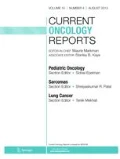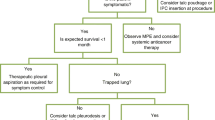Abstract
Malignant pleural effusion (MPE) often presents in patients with cancer at an advanced stage and thus carries a poor prognosis. This review updates the current knowledge on the management of MPE, focusing on recent literature about the efficacy and safety of the most common methods, including pleurodesis by either thoracoscopy with talc insufflation or thoracostomy with talc slurry, use of an indwelling pleural catheter, and intrapleural chemotherapy. Talc remains the agent of choice in pleurodesis, although the use of alternative agents continues to be explored. The choice of procedure to achieve pleurodesis depends on careful patient selection based on predictive factors and individual characteristics. Talc pleurodesis is relatively well tolerated and safe, as is an indwelling pleural catheter, in an appropriate patient population. Because MPE is a common problem in cancer patients, future research with more randomized, prospective designs and innovative interventions is needed.
Similar content being viewed by others
References and Recommended Reading
Antony VB, Loddenkemper R, Astoul P, et al.: Management of malignant pleural effusions. Am J Respir Crit Care Med 2000, 162:1987–2001.
Bethune N: Pleural poudrage. A new technique for the deliberate production of pleural adhesion as a preliminary to lobectomy. J Thorac Surg 1935, 4:251–261.
Tan C, Sedrakyan A, Browne J, et al.: The evidence on the effectiveness of management for malignant pleural effusion: a systematic review. Eur J Cardiothorac Surg 2006, 29:829–838.
Dresler CM, Olak J, Herndon JE, et al.: Phase III intergroup study of talc poudrage vs talc slurry sclerosis for malignant pleural effusion. Chest 2005, 127:909–915.
Marrazzo A, Noto A, Casa L, et al.: Video-thoracoscopic surgical pleurodesis in the management of malignant pleural effusion: the importance of an early intervention. J Pain Symptom Manage 2005, 30:75–79.
Kolschmann S, Ballin A, Gillissen A: Clinical efficacy and safety of thoracoscopic talc pleurodesis in malignant pleural effusions. Chest 2005, 128:1431–1435.
Stefani A, Natali P, Casali C, Morandi U: Talc poudrage versus talc slurry in the treatment of malignant pleural effusion. A prospective comparative study. Eur J Cardiothorac Surg 2006, 30:827–832.
Goodman A, Davies CW: Efficacy of short-term versus long-term chest tube drainage following talc slurry pleurodesis in patients with malignant pleural effusions: a randomised trial. Lung Cancer 2006, 54:51–55.
Janssen JP, Collier G, Astoul P, et al.: Safety of pleurodesis with talc poudrage in malignant pleural effusion: a prospective cohort study. Lancet 2007, 369:1535–1539.
Aelony Y: Talc pleurodesis and acute respiratory distress syndrome. Lancet 2007, 369:1494–1496.
Froudarakis ME, Klimathianaki M, Pougounias M: Systemic inflammatory reaction after thoracoscopic talc poudrage. Chest 2006, 129:356–361.
Yildirim E, Dural K, Yazkan R, et al.: Rapid pleurodesis in symptomatic malignant pleural effusion. Eur J Cardiothorac Surg 2005, 27:19–22.
Akopov AL, Egorov VI, Varlamov VV, et al.: Thoracoscopic collagen pleurodesis in the treatment of malignant pleural effusions. Eur J Cardiothorac Surg 2005, 28:750–753.
van den Toorn LM, Schaap E, Surmont VF, et al.: Management of recurrent malignant pleural effusions with a chronic indwelling pleural catheter. Lung Cancer 2005, 50:123–127.
Tremblay A, Michaud G: Single-center experience with 250 tunnelled pleural catheter insertions for malignant pleural effusion. Chest 2006, 129:362–368.
Warren WH, Kim AW, Liptay MJ: Identification of clinical factors predicting PleurX catheter removal in patients treated for malignant pleural effusion. Eur J Cardiothorac Surg 2008, 33:89–94.
Jimenez CA, Mhatre AD, Martinez CH, et al.: Use of an indwelling pleural catheter for the management of recurrent chylothorax in patients with cancer. Chest 2007, 132:1584–1590.
Janes SM, Rahman NM, Davies RJ, Lee YC: Catheter-tract metastases associated with chronic indwelling pleural catheters. Chest 2007, 131:1232–1234.
Seto T, Ushijima S, Yamamoto H, et al.: Intrapleural hypotonic cisplatin treatment for malignant pleural effusion in 80 patients with non-small-cell lung cancer: a multi-institutional phase II trial. Br J Cancer 2006, 95:717–721.
Postmus PE, Brambilla E, Chansky K, et al.: The IASLC Lung Cancer Staging Project: proposals for the revision of the TNM stage groupings in the forthcoming (seventh) edition of the TNM classification of malignant tumours. J Thorac Oncol 2007, 2:686–693.
Goldstraw P, Crowley J, Chansky K, et al.: The IASLC Lung Cancer Staging Project: proposals for the revision of the TNM stage groupings in the forthcoming (seventh) edition of the TNM classification of malignant tumours. J Thorac Oncol 2007, 2:706–714.
Haas AR, Sterman DH, Musani AI: Malignant pleural effusions: management options with consideration of coding, billing, and a decision approach. Chest 2007, 132:1036–1041.
Antevil JL, Putnam JB Jr: Tale pleurodesis for malignant effusions is preferred over the PleurX catheter (pro position). Ann Surg Oncol 2007, 14:2698–2699.
Warren WH: Talc pleurodesis for malignant pleural effusions is preferred over the PleurX catheter (contrary position). Ann Surg Oncol 2007, 14:2700–2701.
Sterman DH, Recio A, Vachani A, et al.: Long-term follow-up of patients with malignant pleural mesothelioma receiving high-dose adenovirus herpes simplex thymidine kinase/ganciclovir suicide gene therapy. Clin Cancer Res 2005, 11:7444–7453.
Sack U, Hoffmann M, Zhao XJ, et al.: Vascular endothelial growth factor in pleural effusions of different origin. Eur Respir J 2005, 25:600–604.
Pichelmayer O, Gruenberger B, Zielinski C, Raderer M: Bevacizumab is active in malignant effusion. Ann Oncol 2006, 17:1853.
Author information
Authors and Affiliations
Corresponding author
Rights and permissions
About this article
Cite this article
Chen, H., Brahmer, J. Management of malignant pleural effusion. Curr Oncol Rep 10, 287–293 (2008). https://doi.org/10.1007/s11912-008-0045-4
Published:
Issue Date:
DOI: https://doi.org/10.1007/s11912-008-0045-4




